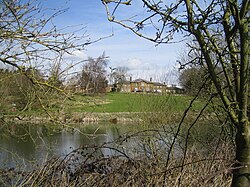Caswell, Northamptonshire
| Caswell | |
| Northamptonshire | |
|---|---|
 Allen Clark Research Centre, Caswell | |
| Location | |
| Grid reference: | SP651511 |
| Location: | 52°9’16"N, 1°2’57"W |
| Data | |
| Post town: | Towcester |
| Postcode: | NN12 |
| Dialling code: | 01327 |
| Local Government | |
| Council: | West Northamptonshire |
| Parliamentary constituency: |
South Northamptonshire |
Caswell is a lost village within the Parish of Greens Norton in Northamptonshire, in the south of the county, three miles north-west of Towcester and eight miles south-west of Northampton. Where once was a village now it consists almost entirely of Caswell Park science and technology park, which has developed since the 1940s around a 19th-century farmhouse.
Caswell House
The farmhouse was built for the Duke of Grafton's estate around 1840,[1] at the same time as another at Field Burcote, about a mile to the west.[2] Both have three widely spaced bays with low-pitched hipped slate roofs and lower wings, and are formally arranged.[3] @The building and its single-storey outbuildings, although much altered in the 20th century, are Grade II listed.
Research establishment
Plessy created a materials research laboratory in 1934, founded by Allen George Clark and William O. Heyne in Ilford in Essex.[4] In 1940, the German bombing campaign encroached upon Ilford and so the director, Geoffrey Gaut, relocated the laboratory to Caswell, a quieter, country environment where research could proceed undisturbed. The company bought the entire farm in 1945, Gaut and his family living in the farmhouse.
By 1950, the number of research staff at Plessey Research Caswell had reached 50, local pre-production units was created, and the establishment of least a further eight independent businesses locally in the Towcester area, especially around Wood Burcote, just south of the town.[4]
For the next 50 or so years, the site became the home of the Allen Clark Research Centre, named as a memorial to the founder. Plessey sold some 207 acres of the farm's land in 1968, retaining 23 acres.
Research was carried out in a number of areas including semiconductors, LED's, other solid-state devices and integrated circuits.[5] Caswell was the birthplace of self scanned C-MOS light sensor arrays (PJW Noble) for Plessey Semiconductors, based at Cheney Manor, Swindon.
Amongst the advances made here, Caswell technologists developed the first multilayer ceramic capacitor and a host of other inventions that enabled the elements of modern communications..[6]
References
- ↑ National Heritage List 1371627: Caswell Farmhouse and attached outbuildings (Grade @ listing)
- ↑ National Heritage List 1294374: Field Burcote Farmhouse (Grade @ listing)
- ↑ Nikolaus Pevsner: The Buildings of England: Northamptonshire, 1961; 1973 Penguin Books ISBN 978-0-300-09632-3page 240
- ↑ 4.0 4.1 "Solid-State Research at Caswell: J Phys Technol Vol 17 (1986): includes pictures of the site and some early ICs". http://iopscience.iop.org/0305-4624/17/3/405/pdf?ejredirect=.iopscience. Retrieved 7 October 2009.
- ↑ Duncan, Helen (9 March 2009). "This is your life: Caswell Research Centre". https://www.newelectronics.co.uk/electronics-technology/this-is-your-life/17388/.
- ↑ "This is Your Life, Caswell – the cradle of the semiconductor industry: New Electronics, 9 March 2009". http://www.newelectronics.co.uk/electronics-technology/this-is-your-life/17388/. Retrieved 13 September 2015.